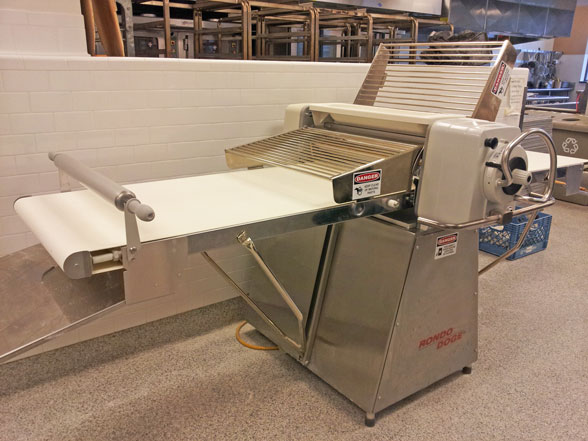
This beast is a dough sheeter. It is basically a giant mechanical rolling pin. The white flat area works like a treadmill, and the straight silver handles at the front control the direction the treadmill runs. In the center of the machine is a roller that can be raised or lowered via the rounded silver handles. You put a block of dough on one side, and run it back and forth under the roller/presser, and it creates a beautifully even, flat sheet. I took this photo early in the morning, before the kitchen filled with busy bakers.
This week (and next week) my rotation is Doughs. I'm working with the Bread chef. As best I can tell, "Doughs" are yeasted or laminated doughs that are not bread; croissants, brioche, sweet rolls, and the like. I made three batches of dough early in the week: one plain sweet roll dough, one ditto with cardamom and grated orange peel, and one batch of pain au lait dough. The rest of the week I was making these doughs up into various sweet rolls. The basic technique was the same for all the products.
First step in bread-type dough making is always to prepare your mise en place: get all the ingredients measured and prepped, and gather any equipment you might need to use. All these doughs called for flour, eggs, liquid (milk or water), instant yeast and butter. I used instant "gold" yeast, which is a special kind of yeast that is "osmotolerant" - it can handle the high amount of sugar in sweet yeast doughs (although sugar is food for yeast, a large proportion of sugar can actually slow down growth for ordinary types of yeast).
Second step is to mix the dough. The sweet roll and pain au lait both require an intensive mix. The liquid, eggs, flour and yeast go into the stand mixer, where they get beaten (with a dough hook) for a few minutes at low speed until the dough comes together (all parts are incorporated into the dough), then the dough is beaten at high speed for five to seven minutes, until the dough "windows" (spreading a bit of dough with your fingers creates a thin window that doesn't break). Then the mixer is turned to medium speed, and bits of butter are fed in to be incorporated gradually.
Then the bulk fermenting stage: let the lovely soft yeasty dough sit out at room temperature for an hour, then let it rest overnight (at least) in the fridge, so the yeast can continue to grow slowly.
The rest of the week was building and baking product. For all the products, I used the same initial method: take half of a batch of dough (about 5 pounds), form it into a block (about 12 x 12 x 4 inches), and run it through the sheeter until it is 3/8 inches thick, at which point it is a sheet of dough about 5 feet by 2 feet.
I made several versions of sweet rolls. Cardamom-currant ones, where I'd spread cardamom-infused pastry cream very thinly on the dough, sprinkle currants all over, then roll up from the long side. Sticky rolls (brush the dough with melted butter, sprinkle cinnamon sugar, and roll up) and Cinnamon rolls (brush with butter, spread with brown sugar and cinnamon, and sprinkle on chopped walnuts before rolling). For all the rolls, I cut the long roll into several pieces and put them on parchment on a sheet pan, thence into the blast freezer for a half hour or so, to make them easier to slice.
I also made two pastries that were cut rather than rolled. The beauties below were made from the pain au lait dough, sheeted as usual, then cut into squares. Pistachio pastry cream piped diagonally, add a stick of dark chocolate (a.k.a. batard), fold the opposite points in. The other cut pastry was lemon cups: sheet the dough, cut circles, put them in a muffin pan to make little cups, then add lemon curd.
All of these pastries had a spell in the proof box before baking, and all got an egg wash (proportions are one whole egg plus one egg yolk) before baking. I did not get everything baked this week - some went into the freezer for the weekend and will get baked next week. The kitchens/chefs at school are very attentive to using up leftovers - very little goes to waste. I made one batch of pastry cream (the cardamom one) but the rest of the cream and lemon curd that I used were actually left over from someone else's projects.
I didn't burn anything this week except my arm (on the rotating / rack oven). I noticed that the senior students have varying quantities of these little burn scars on their forearms - they are something of a badge of honor (or clumsiness).

Breads! Sounds fascinating. Not only the chemistry and biology involved but I find that of all baked goods they are the most interesting. So many possibilities. I noticed that the Buzz sells bread. I was wondering when is the best time to pick some up, or is it fresh every day?
ReplyDeleteIt is fresh every Wednesday, Thursday and Friday for sure, usually the bread starts coming downstairs around 11:30. Friday is generally the highest volume because we're baking off everything we can before the weekend.
DeleteAny varieties that particularly stand out?
DeleteThe round loaves marked as "country" or 'levain" are generally reliably good. 3rd and 4th quarter students will often make specialty breads so each day can have different ones. There are good baguettes every day too, the traditional French kind, chewy and hole-y.
ReplyDeleteThis comment has been removed by the author.
Delete"Hole-y baguettes, Batman!" Sounds like a great line for "Batman and Robin vs The Master Chef" ;-)
DeleteLove your bio photo!
ReplyDelete